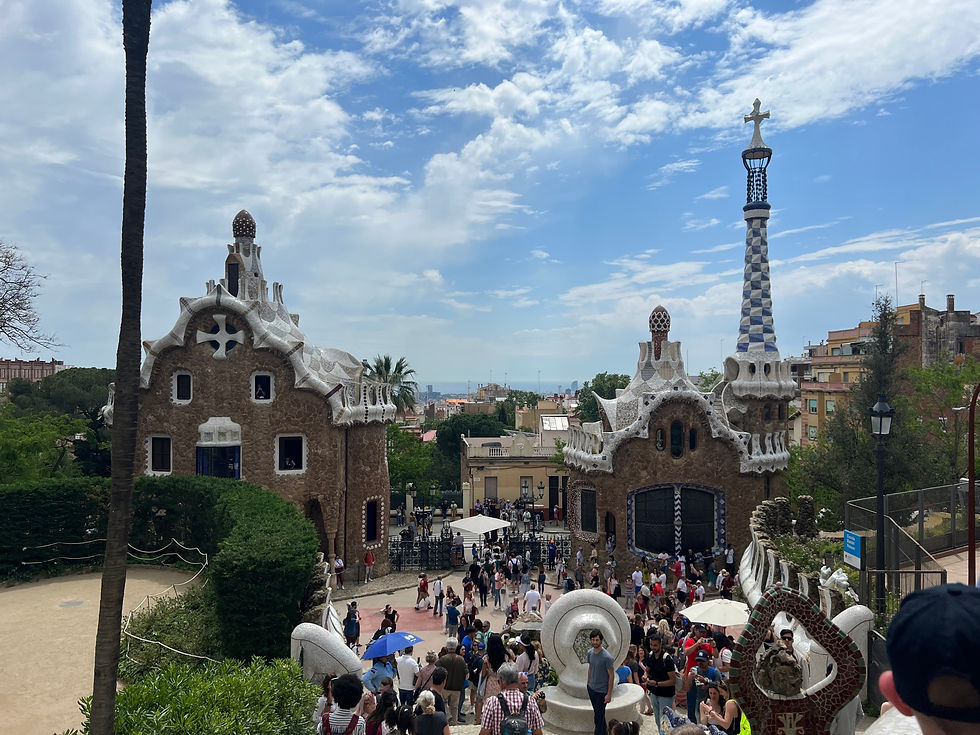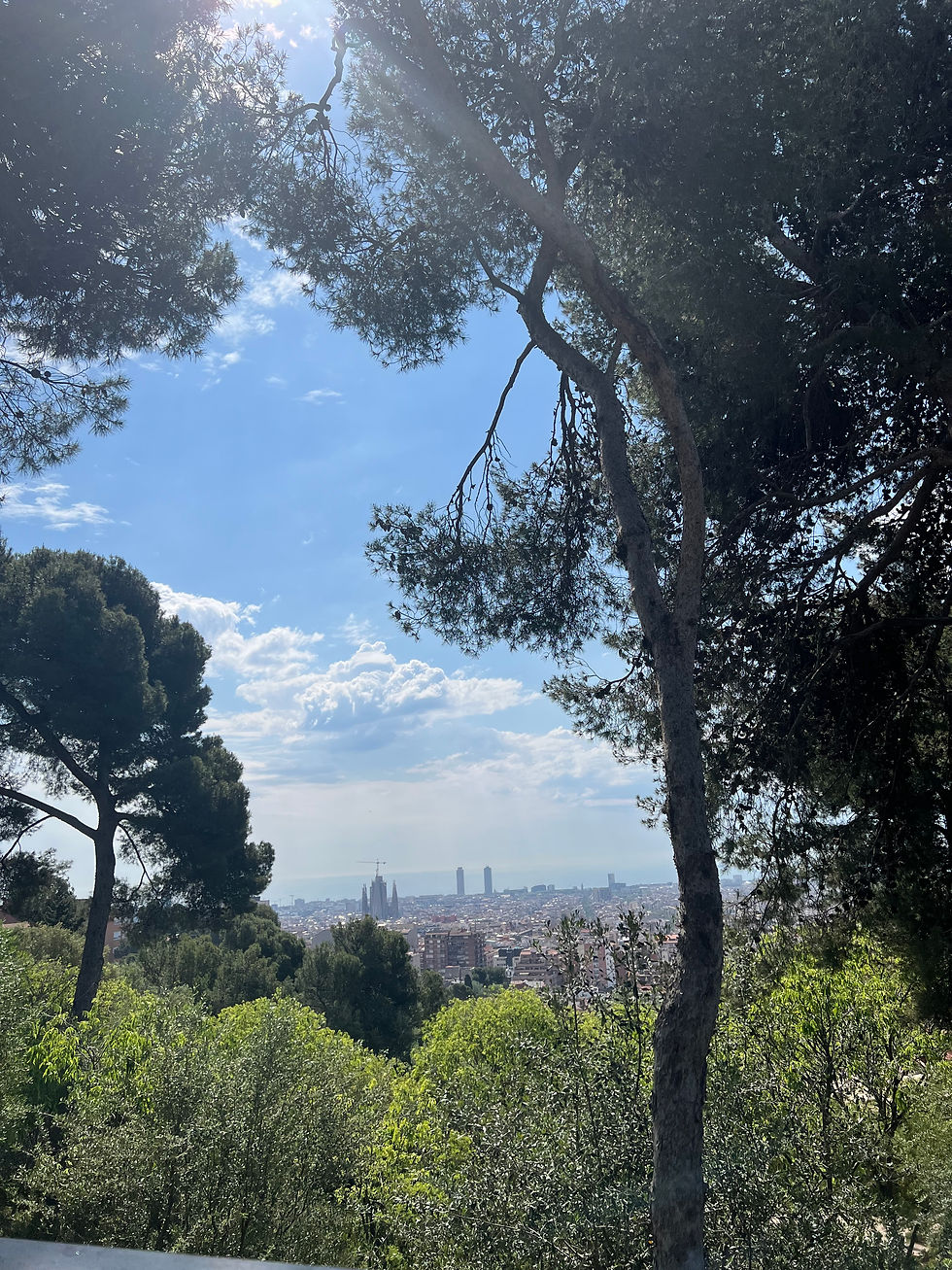Not Your Average Walk in the Park
- alexah1111
- Jun 4, 2022
- 5 min read
By: Alexa Herrera
It is never just a regular walk in the park at Gaudi’s famous Park Güell. With mosaics, giant statues and breathtaking views of Barcelona, this park is a must see for anyone visiting Barcelona.
You will marvel at the architecture of the park and can enjoy a stroll through the different areas. Whether you want to hike up to the highest point of the park or sit on a colorful bench and enjoy the weather, Park Güell has something for everyone.
History of the Park
At first, the park was created for the wealthy Eusebi Güell, a businessman, purchased a piece of land on the outskirts of Barcelona.
Güell hired Antoni Gaudí to build a modern housing estate on the land inspired by the British residential parks.
Gaudí was instructed to construct houses, a school, church and a market. In 1900, construction started.
The first person to purchase a plot in the park was a lawyer named Martí Trias i Domènech. He commissioned an architect to build his villa in 1902.
Gaudí himself moved there in1906 to live with his father and niece. Then, in 1907, Güell converted the old mansion that was already there into his residence.
However, the plans to build this private estate soon crumbled due to a lack of buyers. There were a number of things wrong with the park including a lack of an adequate transportation system to get there.
Construction stopped in 1914 with only two of the 60 prospective houses built. Instead, the park became a private garden used for public events.
After Güell died in 1918, the city council bought the park and it was opened to the public in 1926. The Güell family house was transformed into a school, and Gaudí’s house was turned into a museum, which was opened to the public in 1963.

Antoni Gaudí’s former home was turned into the Gaudí House Museum, and it costs an extra €5 to go inside.
It was recognized as an artistic monument in 1969 and declared a UNESCO World Heritage Site in 1984.
The Monument’s Area
The park is divided into two parts: the forest and the monument’s area. The main entrance leads you to the monument’s area, which is where most of Gaudí’s work is.
The first two buildings you will see when you walk in are Casa del Guarda where the doormen used to sleep and Pabelló de l’Aministració. The first was turned into a museum, and the latter is now a souvenir shop.
As visitors continue into the park, they will see the grand staircase and the almost eight foot long salamander. This statue is called El Drac and is made of broken tiles of mosaic using Gaudí’s technique of trencadís.

People have different interpretations of what the salamander represents. Some think it represents the City of Nimes where Eusebi Güell grew up.
Gaudí’s architecture always had a symbolic meaning behind it and elements in the park reflect that. The statue sits in a nook that is red and yellow, which are the colors of Catalonia. The stairs also represents the stairway to heaven,

The columns that you see in the picture support La Plaça and there are 86 of them.
Beyond the stairs is La Plaça surrounded by the Serpentine Bench where the backing is made of colorful mosaic tiles, and it is curvy like a snake.
Carlos Fonseca, a visitor and an art student, said the Serpentine Bench was his favorite part of the park.
“Gaudí, to me, was a genius who was able to put a meaning behind something as simple as a bench,” he said.
Gaudí was inspired by nature when choosing the colors of the architecture here. Just like in Casa Batlló, which was also designed by him, he draws inspiration from nature throughout the park.

As you can see in this picture, there are no straight lines in the park because it was inspired by nature, and there are no straight lines in nature according to Gaudí
After visitors go up the grand staircase, they can see the hypostyle room. As you marvel over the vast number of columns, you can look up and see more broken pieces of mosaic arranged in different patterns.

The roof of the hypostyle room is made up of small domes by Josep Jujol, which was Gaudí’s assistant.
The Forest
After you are done exploring the monument area, you can explore one of the many trails in the forest area.
Visitors can walk uphill to the highest point in the park known as El Calvari. This point was originally supposed to house a chapel, but instead, Gaudí built a monument with three crosses.

From this picture you can only see two crosses but the highest of the three represents Jesus.
“It was quite the walk up here, but it was worth it to look at the view of the city,” said Isabel D’Angelou, a visitor from the United States.

The view from the three crosses includes La Sagrada Familia.
She said she loved both areas of the park, but she would save the three crosses for last since it is a long walk.
"Park Güell is a must see for anyone who is visiting Barcelona and wants to be immersed in an artwork," D"Angelou said.
Tickets and Times
Park Güell is open daily from 9:30 a.m. to 7:30 p.m. from March to October. During other months, the park closes an hour or two earlier.
It is most crowded during April through August and most visitors go on the weekend. To avoid large crowds, it is best to go during the weekdays and not during the peak season.
There are three different types of ticket options you can choose from. The first is a timed entry ticket which costs €10.
This ticket allows visitors to enter within 30 minutes of the time slot and stay for as long as they like.
The second type of ticket is for a guided tour and skip the line entry costing €23. The tour is one hour and 15 minutes long, and the tour comes in 4 languages you can choose from.
The last type of ticket includes a tour of the park and Sagrada Familia for €79. This is about three to four hours long and includes a transfer between the two locations.
Visitors who are 6 and below can enter for free, children 7-12 and adults over 65 receive a discounted price and people with disabilities can enter for free.
Attention to detail
Park Güell is a unique park for anyone who wants to learn more about Gaudí, look at the magnificent architecture or just take a stroll through the greenery.
The park features many different architectural pieces such as the three crosses, the Serpentine Bench, El Drac and other pieces that will make you wonder how they were made.
You can appreciate the attention to detail on every work and how Gaudí managed to create everything with a meaning behind it.









Comments